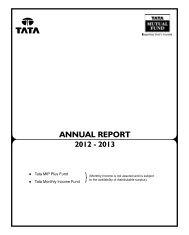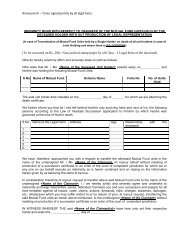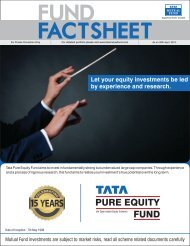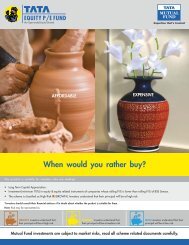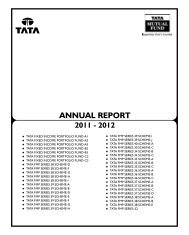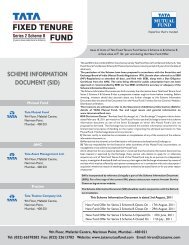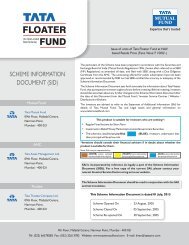TMF Intellect-August-07 - Tata Mutual Fund
TMF Intellect-August-07 - Tata Mutual Fund
TMF Intellect-August-07 - Tata Mutual Fund
You also want an ePaper? Increase the reach of your titles
YUMPU automatically turns print PDFs into web optimized ePapers that Google loves.
A Monthly Newsletter by<br />
INTELLECT<br />
For internal circulation only<br />
VOLUME 6: <strong>August</strong>, 20<strong>07</strong><br />
Sub-prime<br />
Mess
LEARNING<br />
Sub prime Mess: Let the g(bl)ame begin<br />
Origin of Subprime:<br />
Prime Loans also means A-paper loan it is a term used to<br />
describe a mortgage loan where the asset and borrower<br />
meet the following criteria:<br />
In the United States, the borrower has a credit score of 680<br />
or higher<br />
The borrower fully documents their income and assets<br />
The borrower’s debt to income ratio does not exceed 35%<br />
The borrower retains 2 months of mortgage payments in<br />
reserves after closing<br />
The borrower injects at least 20% equity<br />
In short, prime loan means a loan given to a borrower having<br />
good credit history and good earnings potential clubbed with<br />
strong security in terms of cash or assets.<br />
Sub prime loans means B-paper loan where the asset and the<br />
borrower does not fulfill the mandatory criteria for borrowing<br />
a loan<br />
In the US housing boom which started in the 1990's every thing<br />
seemed hunky-dory then. In this boom the brokers of housing<br />
loan had a time of their life as they pushed in for loans to the<br />
borrowers who cannot afford it and made good fees out of it.<br />
This pile of junk loans quintupled over the years and found its<br />
way into various debt papers, bonds and CDO's (explained<br />
later in the article). Not only did it find its way in to Wall Street<br />
but also plagued various geographies globally.<br />
As you check the flow sheet of how the Sub prime money trail<br />
you will find that the mess is a cumulative efforts of the greed at<br />
all levels. Starting from prospective home owners who bought<br />
something which they didn't deserve or afford, to the home<br />
loan brokers and then from banks & financial institutions who<br />
bought this loan and bundled them in to CDO's, to ultimately<br />
the Credit rating agency who rated them as investible assets,<br />
#<br />
before the CDO -producers floated them in the secondary<br />
markets for trading.<br />
Recent diaspora of this plague was reported by BNP Paribas<br />
where it stopped any further withdrawals from three of its<br />
funds as they couldn't value their assets. Bear Sterns & Co.,<br />
Credit Siusse etc. few of many following the trail.<br />
It is exactly antonym of prime loans these loans are<br />
disbursed to borrowers having poor credit history low<br />
income and earnings potential having less or no collateral<br />
As the borrower and the asset does not meet the mandatory<br />
criteria for loan he has to shell out more money for the loan<br />
in short the interest charged to him is more then charged in<br />
the prime loan. The extra interest he needs to pay to makeup<br />
for low credit score.<br />
Subprime mortgage loans are riskier loans in that they are<br />
made to borrowers unable to qualify under traditional,<br />
more stringent criteria due to a limited or blemished credit<br />
history. Subprime borrowers are generally defined as<br />
individuals with limited income or having FICO* credit<br />
scores below 620 on a scale that ranges from 300 to 850.<br />
Subprime mortgage loans have a much higher rate of<br />
default than prime mortgage loans and are priced based on<br />
the risk assumed by the lender.<br />
If the subprime borrower defaults which is very likely to<br />
happen, then the asset for which loan is taken is foreclosed.
UNDERSTANDING<br />
Where are we going<br />
This subprime mess is set to contaminate various asset class and<br />
investment avenue across the globe. As the old saying goes –<br />
“One rotten mango spoils the whole basket”<br />
Immediate catastrophe in US<br />
Credit crunch<br />
Negative momentum in home sales, inventory and prices<br />
Assumption<br />
Partial mean-reversion of home prices<br />
This can be a very slow train, but its direction is very clear<br />
Cascading effect Globally<br />
Economies exporting heavily to US would get a jolt. As US<br />
housing slump increases lesser people will spend for<br />
households, FMCG and white goods products hence retail<br />
sales will be affected.<br />
Credit crunch : Lenders are getting more tightfisted as<br />
more tough times loom for housing. Hence lesser the<br />
lending lesser is the borrowing again agitating the housing<br />
slump.<br />
Coporate Credit : The private equity and stock buyback<br />
booms of the past few years, both fueled by cheap debt,<br />
could slow. If that happens, the stock markets, which has<br />
broken records recently, would lose two critical legs of<br />
support. And if companies are starved of capital the<br />
economy may slow too.<br />
As US dollar weakens against various currencies the trade<br />
deficit takes a hit. Yen which has strengthened against<br />
dollar substantially has affected the cash and carry trade.<br />
Usually investors buy yen, which was cheaper, and invest in<br />
high yield economies, especially the emerging markets.<br />
Although currency fluctuations cannot be directly linked<br />
to subprime crisis but surely has a role to play.<br />
Balking at buy-outs: Nervous debt investors are forcing<br />
companies to renegotiate terms, delay offerings, or fund<br />
deals.<br />
India as an Economy so far has not reported any direct impact of the subprime mess, but the stock markets have definitely<br />
reacted to the global cues. Indian markets are heading for major corrections and volatility just like other bourses globally.<br />
As many FII’s and foreign funds who have had exposure to these subprime debt are realigning their portfolios we might see<br />
foreign funds dry out. Also not to forget the Yen cash and carry trade impact.<br />
The US Subprime mortgage meltdown has shaved off Rs 2,40,000 crore market capitalization on the Bombay Stock Exchange<br />
in fourteen sessions. The Benchmark Sensex has declined by 5.87% (900 points) from its peak of 15975 on July 24, 20<strong>07</strong>.<br />
Realty, metal, automobiles, capital goods and bank indices have declined by over 6 per cent each. Oil & gas, healthcare, IT<br />
and consumer durables indices managed to weather the meltdown, declining below 5 per cent each (as on date when this<br />
article was written 2nd week of <strong>August</strong>).<br />
Over a short term our markets tend to be volatile following the global cues. However it should be noted that Indian economy<br />
is not an export oriented one rather depends more on domestic consumption and expenditure of the total GDP, 50-60% is<br />
domestic consumption, 25-30% is expenditure and remaining 10% is export's another interesting point is out of total exports<br />
only 15-20% goes to USA. Hence, any slowdown in USA would not hurt the growth of the Indian Economy severely. Markets<br />
would definitely see a correction but long term India growth story remain intact. CHAK DE INDIA!!
UNDERSTANDING<br />
Subprime Mess<br />
UNDERSTANDING<br />
1 2 3 4 Securitization/<br />
Subprime<br />
Housing Loan<br />
Brokers who<br />
fudge docs & Facilitates loans<br />
Bank or financial<br />
Institution who<br />
finance those papers<br />
At this stage Banks package Subprime Loans into mortgage bank securities and CDO.In this CDO<br />
let us consider that other securities are highly rated quality loans and other asset backed<br />
securities mixed worth subprime loan.<br />
CDO's<br />
manufacture of CDOs<br />
Wall Street banks package subprime loans into<br />
mortgage-backed securities and collateralized<br />
debt obligations. Sales of new MBSs soared to<br />
$2.4 trillion in 2006.<br />
High<br />
Rated<br />
Paper<br />
ABS<br />
CDO Squareds<br />
5<br />
Subprime<br />
Loan<br />
AAA+<br />
Paper<br />
CDO Cubeds<br />
5.1 5.2<br />
7<br />
CDO'<br />
s<br />
A CDO is a company typically including offshore that<br />
bags collaterals such as bonds, mortgage-backed<br />
securities and loans and bundles it into debt securities<br />
within varying risks.<br />
When a CDO collaterals consisting of pieces of other<br />
CDO's is called a CDO squared when a CDO is built of<br />
CDO Squareds it is called CDO cubeds.<br />
6<br />
Bankers<br />
C e i Rati g<br />
r d t n<br />
Agencies<br />
This CDO is brought by investors and traded in<br />
the market. In 2006, an estimated $100 billion of<br />
subprime debt went in to $375 billion in US<br />
When a bank makes CDO, it meets Credit Raters<br />
to discuss the quality of the contents, including<br />
subprime debt. They divide the CDO into pieces in<br />
order to get desired ratings.
UNDERSTANDING<br />
Damage so far<br />
The Global Equity Markets so far has seen $ 6066.65 billion of<br />
Market Cap wiped out.<br />
MARKET CAP<br />
($ Billion) 7-Jul-<strong>07</strong> 14-Aug-<strong>07</strong> Change<br />
World 59747.80 56098.15 -3649.66<br />
United States 18481.25 17433.92 -1047.33<br />
United Kingdom 4054.88 3711.10 -343.78<br />
France 2844.11 2609.65 -234.45<br />
Japan 5004.12 4778.06 -226.06<br />
Australia 1221.50 1051.10 -170.40<br />
Hong Kong 2257.54 2093.64 -163.90<br />
South Korea 1158.80 1057.14 -101.66<br />
India 1145.72 1092.36 -53.36<br />
Malaysia 309.22 268.38 -40.85<br />
Thailand 213.55 178.35 -35.20<br />
Source: Bloomberg<br />
Glossary:<br />
*FICO - Fair Isaac Corporation founded in 1956, it provides consulting services and enterprise decision management systems.<br />
They developed the FICO scores, a measure of credit risk, that are the most used credit scores in the world<br />
#<br />
CDO<br />
- Collateralized Debt Obligations<br />
For your feedback write to us at: pradyumn@tataamc.com<br />
Disclaimer:<br />
The information contained in this report are compiled from various sources and external research. <strong>Tata</strong> Asset Management Limited<br />
and its personnel exercise due care and caution in collecting the data before making this report. In spite of this if any omission,<br />
inaccuracy or typing errors occur with regard to the data contained in this. <strong>Tata</strong> Asset Management Limited or any of its personnel<br />
will not be held responsible or liable. The content hereof does not constitute any form of advice, recommendation or arrangement by<br />
<strong>Tata</strong> Asset Management Limited and is not intended to be relied upon by readers in making any specific or other decision.
Our Performance - Track Record<br />
Annualized return (% CAGR) As on 31st July, 20<strong>07</strong><br />
1 - Year 3 - Year 5 - Year Since Inception Period Since Inception<br />
<strong>Tata</strong> Equity Opportunities <strong>Fund</strong> (TEOF)* 54.00 50.91 55.24 14.29 (12.61) 14 yrs.<br />
<strong>Tata</strong> Pure Equity <strong>Fund</strong> (TPEF) 48.98 48.57 50.48 34.85 (15.62) 9 yrs.<br />
<strong>Tata</strong> Select Equity <strong>Fund</strong> (TSEF) 57.87 55.21 49.63 23.39 (13.66) 11 yrs.<br />
<strong>Tata</strong> Life Sciences & Technology <strong>Fund</strong> (TLSTF) 38.00 41.24 44.18 24.20 (17.59) 8 yrs.<br />
<strong>Tata</strong> Tax Saving <strong>Fund</strong> (TTSF) 44.37 41.79 45.29 27.88 (14.45) 11 yrs.<br />
<strong>Tata</strong> Growth <strong>Fund</strong> (Dividend option) (TGF)* 57.93 44.62 43.63 11.94 (10.68) 13 yrs.<br />
<strong>Tata</strong> Infrastructure <strong>Fund</strong> (TISF) 66.66 - - 51.58 (39.37) 2 ½ yrs.<br />
<strong>Tata</strong> Service Industries <strong>Fund</strong> (TSIF) 58.13 - - 40.78 (45.15) 2 yrs.<br />
<strong>Tata</strong> Equity P/E <strong>Fund</strong> (TEPEF) 64.75 44.80 - 46.00 (45.93) 3 yrs.<br />
BSE SENSEX 44.74 44.35 39.06 - -<br />
<strong>Tata</strong> Balanced <strong>Fund</strong> 44.40 38.47 36.93 19.03 11 yrs.<br />
Crisil Balanced <strong>Fund</strong> Index 28.64 25.13 24.14 - -<br />
* These funds were earlier managed by Indian Bank <strong>Mutual</strong> <strong>Fund</strong>. After their take over by TAM in the year 2001, their portfolio & management were totally recast.<br />
Past performance may or may not be sustained in future. Returns are given for growth option. No figures available for other periods of Crisil Balanced <strong>Fund</strong><br />
Index. Figures in brackets indicate benchmark returns for the corresponding period. Date of Allotment: TEOF - Feb 25,1993; TPEF - May 7, 1998; TSEF - May<br />
24,1996; TLSTF - Jul 2, 1999; TTSF- Mar 31, 1996; TGF - Jul 1,1994; TISF - Dec 31, 2004; TSIF - Apr 05, 2005; TEPEF - Jun 29, 2004; TBF - Oct 8, 1995.<br />
<strong>Tata</strong> Pure Equity <strong>Fund</strong>: Nature and Investment Objective: An open ended equity scheme. To provide income distribution and / or medium to long term capital gains while at all times emphasising the<br />
importance of capital appreciation. Load Structure (other than SIP): Entry Load: For each investment amount less than Rs 1 crore: 2.25%; For each investment amount greater than or equal to Rs 1<br />
crore: Nil. Exit Load: For investment amount less than Rs. 1 crore: 1% if redeemed on or before expiry of six months from the date of allotment. For investment amount greater than or equal to Rs. 1<br />
crore: NIL. <strong>Tata</strong> Equity Opportunities <strong>Fund</strong>: Nature and Investment Objective: An open ended equity scheme. To provide income distribution and/or medium to long term capital gains while at all<br />
times emphasising the importance of capital appreciation. Load Structure (other than SIP): Entry Load: For each investment amount less than Rs 2 crore: 2.25%; For each investment amount greater<br />
than or equal to Rs 2 crore: Nil. Exit Load: For investment amount less than Rs. 2 crores: 1% if redeemed on or before expiry of six months from the date of allotment. For investment amount greater than<br />
or equal to Rs. 2 crores: NIL. <strong>Tata</strong> Infrastructure <strong>Fund</strong>: Nature and Investment Objective: An open ended equity scheme. The investment objective is to provide income distribution and / or medium to<br />
long term capital gains by investing predominantly in equity / equity related instrument of companies in infrastructure sector. Applicable Loads: Entry Load (other than SIP): For each investment<br />
amount less than Rs 2 crore: 2.25%; For each investment amount greater than or equal to Rs 2 crore: Nil. Exit Load (other than SIP): For investment amount less than Rs. 2 crores: 1% if redeemed on or<br />
before expiry of six months from the date of allotment. For investment amount greater than or equal to Rs. 2 crores: NIL <strong>Tata</strong> Select Equity <strong>Fund</strong>: Nature and Investment Objective: An open-ended<br />
equity scheme. To provide income distribution and/or medium to long-term capital gains while at all times emphasising the importance of capital appreciation. Load Structure: Entry Load (Other than<br />
SIP): For each investment amount greater than or equal to Rs 1cr: Nil. For each investment amount less than Rs 1cr: 2.25%. Exit Load (Other than SIP): For each investment amount greater than or equal<br />
to Rs. 1 cr: Nil. For each investment amount less than Rs.1 cr: 1%, if redeemed within 6 months from date of allotment. <strong>Tata</strong> Life Sciences & Technology <strong>Fund</strong>: Nature & Investment Objective: An<br />
open ended Equity Scheme. To provide income distribution and/or medium to long-term capital gains while at all times emphasizing the importance of capital appreciation. Applicable Loads: Entry<br />
Load (other than in SIP): For Investment amount less than Rs. 2 crores : 2.25%. For Investment amount greater than or equal to Rs. 2 crores : NIL. Exit Load (Other than in SIP): For investment amount<br />
greater than or equal to Rs. 2 crores: NIL. For investment amount less than Rs. 2 crores: 1% if redeemed within 6 months from the date of allotment. <strong>Tata</strong> Service Industries <strong>Fund</strong>: Nature and<br />
Investment Objective: An open ended equity scheme. The investment objective is to provide income distribution and / or medium to long term capital gains by investing predominantly in equity / equity<br />
related instrument of companies in Services sector. Applicable Loads: Entry Load (other than SIP): For Each Investment amount < Rs. 2 Crores: 2.25%. For Each Investment amount >= Rs. 2 crore:<br />
Nil. Exit Load (other than SIP): For investment amount greater than or equal to Rs. 2 Crs: Nil, less than Rs. 2 Crs: 1%, if redeemed within 6 months from date of allotment.<strong>Tata</strong> Growth <strong>Fund</strong>: Nature and<br />
Investment Objective: An open ended equity fund. To provide income distribution and/or medium to long term capital gains while at all times emphasising the importance of capital appreciation. Entry<br />
Load (other than SIP): For investment amount > = Rs 5 crores or more: Nil. For investment amount < Rs 5 crores : 2.25%. Exit Load (other than SIP): Nil. <strong>Tata</strong> Balanced <strong>Fund</strong>: Nature and Investment<br />
Objective: An open ended balanced fund. To provide income distribution and/or medium to long term capital gains while at all times emphasizing the importance of capital appreciation. Load Structure<br />
(other than SIP): Entry Load: For Investment amount less than Rs. 2 crores : 2.25%; For each investment amount greater than or equal to Rs. 2 crores : Nil. Exit Load: For Investment amount greater than<br />
or equal to Rs. 2 crores: Nil, less than Rs. 2 crores 1%, if redeemed within 6 months from the date of allotment. <strong>Tata</strong> Equity P/E <strong>Fund</strong>: Nature and Investment Objective: An open ended equity fund. To<br />
provide reasonable and regular income along with possible capital appreciation to its unitholder. Load Structure: Entry Load (other than SIP): For each investment amount < Rs. 2 crs 2.25%. For each<br />
investment amount >= Rs. 2 crs NIL. Exit Load (other than SIP): NIL. Load Structure (SIP) for TPEF, TEOF, TSEF, TISF, TSIF, TLSTF, TEPEF, TGF, TBF :Entry Load : 1%; Exit Load : if redeemed on or<br />
before expiry of 24 months from the date of allotment : 1.25%; if redeemed after 24 months : Nil. This SIP load structure would be applicable for SIP amount upto Rs 10 lakhs per installment. For SIP<br />
installment above Rs 10 lakhs, the prevailing load structure for investment other than SIP will be applicable. <strong>Tata</strong> Tax Saving <strong>Fund</strong>: Nature and Investment Objective: An open ended equity linked<br />
saving scheme. To provide medium to long term capital gains along with income tax relief to its unitholders while at all times emphasising the importance of capital appreciation. Entry Load: = Rs. 2 crores:Nil Exit Load : Nil, For SIP^: If redeemed on or before expiry of 24 months: 1%, If redeemed after 24 months: Nil. Subject to lock -in as per the terms of the scheme.<br />
Presently 3 years. ^The above load structure would be applicable for SIP amount upto Rs 10 Lakhs per installment. For SIP installment above Rs 10 Lakhs the prevailing load structure for investment<br />
other than SIP will be applicable. Statutory Details: Constitution: <strong>Tata</strong> <strong>Mutual</strong> <strong>Fund</strong> has been set up as a trust under the Indian Trust Act, 1882. Sponsors & Settlors: <strong>Tata</strong> Sons Ltd., <strong>Tata</strong> Investment<br />
Corporation Ltd. Investment Manager: <strong>Tata</strong> Asset Management Ltd. Trustee: <strong>Tata</strong> Trustee Co. Pvt. Ltd. Risk Factors: • <strong>Mutual</strong> <strong>Fund</strong> and securities investments are subject to market risks and there can<br />
be no assurance and no guarantee that the schemes will achieve their objectives. • As with any investment in stocks, shares and securities the NAV of the units under the schemes can go up or down,<br />
depending upon the factors and forces affecting the capital market. • Past performance of the previous Schemes, the Sponsors or its Group affiliates is not indicative of and does not guarantee the<br />
future performance of the Schemes. • <strong>Tata</strong> Pure Equity <strong>Fund</strong>, <strong>Tata</strong> Equity Opportunities <strong>Fund</strong>, <strong>Tata</strong> Infrastructure <strong>Fund</strong>, <strong>Tata</strong> Service Industries <strong>Fund</strong>, <strong>Tata</strong> Select Equity <strong>Fund</strong>, <strong>Tata</strong> Life Science &<br />
Technology <strong>Fund</strong>, <strong>Tata</strong> Tax Saving <strong>Fund</strong>, <strong>Tata</strong> Growth <strong>Fund</strong>, <strong>Tata</strong> Equity P/E <strong>Fund</strong>, <strong>Tata</strong> Balanced <strong>Fund</strong> are only the names of the Schemes and do not in any manner indicate either the quality of the<br />
Schemes, its future prospects or the returns. • The sponsors are not responsible or liable for any loss resulting from the operations of the scheme beyond the initial contribution of Rs.1 lac made by<br />
them towards setting up the <strong>Mutual</strong> <strong>Fund</strong>. • Investment in fixed income securities is subject to interest rate risk, credit risk and liquidity risk. • Pursuant to allotment of bonus units the NAV of the<br />
schemes would fall in proportion to the bonus allotted and as a result the total value of units held by the investor would remain same. •<strong>Tata</strong> Infrastructure <strong>Fund</strong> - The scheme being sectors specific will<br />
be affected by risk associated with the infrastructure sector. <strong>Tata</strong> Service Industries fund - The scheme being sector specific would be investing predominantly in equity and equity related instruments<br />
of the companies in the service sector, it would be riskier than a normal diversified equity scheme. For scheme specific risk factors and other details please read the offer document of the schemes<br />
carefully before investing.
Tap the wealth creation potential of global infrastructure.<br />
NFO Closes on 16th Oct. 20<strong>07</strong>. Units at Rs. 10/- each.<br />
Across the world the infrastructure sector is full of<br />
potential. <strong>Tata</strong> <strong>Mutual</strong> <strong>Fund</strong> has been among the pioneers<br />
in the Indian infrastructure sector through the <strong>Tata</strong><br />
Infrastructure <strong>Fund</strong> (<strong>Tata</strong> Infrastructure <strong>Fund</strong>, a scheme<br />
dedicated to the infrastructure sector). This experience<br />
will help in offering ideal opportunities to invest in the<br />
future of both Indian and overseas infrastructure through<br />
the <strong>Tata</strong> India-Global Infrastructure <strong>Fund</strong>.<br />
Call us at: 1-800-22-0101 SMS: '<strong>TMF</strong>' to 7575 E-mail: kiran@tataamc.com Website: www.tatamutualfund.com<br />
Name, Nature and Investment objective: <strong>Tata</strong> Indo-Global Infrastructure <strong>Fund</strong>: A 3 years close-ended equity scheme. Upon completion of 3 years, the Scheme<br />
will automatically be converted into an open-ended scheme, without any further reference from the <strong>Mutual</strong> <strong>Fund</strong>/Trustee/ Unitholders. The investment objective of the<br />
scheme is to generate long term capital appreciation by investing predominantly in equity and equity related instruments of companies engaged in infrastructure and<br />
infrastructure related sectors and which are incorporated or have their area of primary activity, in India and other parts of the world. Sale at Rs. 10/- per unit for cash at<br />
face value during the New <strong>Fund</strong> Offer. Minimum Investment Amount: Rs. 10,000 and in multiples of Re. 1 thereafter. Investment Pattern : Equity and Equity related<br />
instruments of domestic companies*: 65% - 85%, Foreign Securities* as permitted by SEBI/RBI: 15% - 35%, Debt and Money Market Instruments: Upto 35%.Two<br />
Options for Investment: Dividend Option and Growth Option. Applicable Load Structure & Repurchase facility: Exit Load: NIL NAV publication: Once every week<br />
i.e. on each Wednesday during close ended period and on all business days subsequent to the scheme's conversion into an open end scheme. Repurchase facility:<br />
First Wednesday of every month (immediately next business day if such Wednesday is a holiday) and on all business days subsequent to the scheme's conversion<br />
into an open-ended scheme. New <strong>Fund</strong> Offer Expenses not exceeding 6% of the amount mobilized will be charged to the Scheme and shall be amortized over a close<br />
ended period. In case of redemption before expiry of close ended period, proportionate unamortized NFO expenses will be recovered from the redemption proceeds of<br />
the investors. Investors are urged to study the terms of the Offer carefully and to consult their tax advisor at the time of investment and or redemption of units in the<br />
fund. Statutory Details: Constitution: <strong>Tata</strong> <strong>Mutual</strong> <strong>Fund</strong> (<strong>TMF</strong>) has been set up as a Trust under the Indian Trust Act 1882. Sponsors: <strong>Tata</strong> Sons Limited and <strong>Tata</strong> Investment Corporation<br />
Limited. Trustee: <strong>Tata</strong> Trustee Company Pvt. Ltd. Investment Manager: <strong>Tata</strong> Asset Management Ltd. Risk Factors: All investments in <strong>Mutual</strong> <strong>Fund</strong>s and securities are subject to market<br />
risks and there is no assurance or guarantee that the objectives of the Scheme will be achieved. As with investment in stocks, shares and securities, the NAV of the Scheme can go up or<br />
down depending on factors and forces affecting the Capital Market. Past performance of the previous schemes, the sponsors or its group affiliates are not indicative of and do not<br />
guarantee future performance of the Scheme. The Sponsors are not responsible or liable for any loss resulting from the operation of the Scheme beyond the initial contribution of Rs. 1<br />
Lac made by them towards setting up the mutual fund. Investors in the scheme are not being offered any guaranteed or assured rate of return. <strong>Tata</strong> Indo-Global Infrastructure <strong>Fund</strong> is<br />
only the name of the scheme and does not in any manner indicate either the quality of the schemes, its future prospects or returns. Investment in foreign Securities in subject to various<br />
risks such as currency fluctuations, restrictions on repatriation, changes in regulations, political, economic and social instability and the prevalent tax laws of the respective jurisdictions.<br />
For scheme specific risk factors and other details please read the offer document carefully before investing. Copy of Offer Document and Key Information Memorandum along with<br />
application form may be obtained from the office of <strong>Tata</strong> <strong>Mutual</strong> <strong>Fund</strong>, Fort House, 221, Dr. D. N. Road, Mumbai 400 001 or at your nearest collection centres.<br />
*predominantly in companies engaged in infrastructure / infrastructure related sectors. (It also includes units of overseas mutual funds and exchange traded funds which invest<br />
predominantly in equity / equity related instruments of companies engaged in infrastructure sectors and infrastructure related sectors).<br />
08/20<strong>07</strong>




